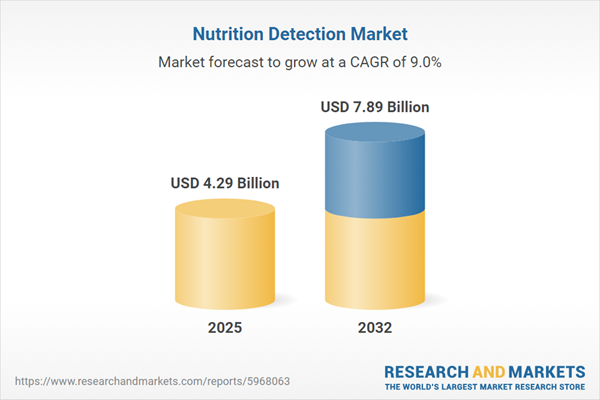Speak directly to the analyst to clarify any post sales queries you may have.
The nutrition detection market is evolving rapidly as innovation in health and food technology fuels demand for accurate, real-time analysis. Senior leaders need clarity on growth patterns, risks, and opportunity areas shaping this essential sector.
Market Snapshot: Nutrition Detection Market Growth and Outlook
The Nutrition Detection Market grew from USD 3.95 billion in 2024 to USD 4.29 billion in 2025. It is expected to continue growing at a CAGR of 9.02%, reaching USD 7.89 billion by 2032.
Scope & Segmentation
- Analyte Types: Bioactives (including carotenoids, polyphenols, probiotics/prebiotics), Macronutrients (carbohydrate, energy/calories, fat, fiber, moisture, protein), and Micronutrients (macro minerals, trace minerals, fat-soluble vitamins, water-soluble vitamins).
- Technology Platforms: Biosensors (electrochemical, optical, piezoelectric), Chromatography (gas, HPLC, ion, thin-layer), Mass Spectrometry, and Spectroscopy (fluorescence, NMR, UV-Visible).
- Sample Types: Animal feed, biological samples (blood, breath, saliva, urine), dietary supplements (herbal & botanicals, protein powders, vitamins & minerals), food & beverage (alcoholic beverages, non-alcoholic beverages, dairy, grains & cereals, meat and seafood, oils & fats, produce), and plant & soil.
- Applications: Clinical diagnostics (metabolic disorders, vitamin deficiency), food testing (contaminant detection, nutrient analysis), and pharmaceutical.
- End Users: Food & beverage manufacturers, government agencies, hospitals & clinics, and research laboratories.
- Geographical Regions: Americas (North America with the United States, Canada, Mexico; Latin America with Brazil, Argentina, Chile, Colombia, Peru), Europe, Middle East & Africa (including United Kingdom, Germany, France, Russia, Italy, Spain, Netherlands, Sweden, Poland, Switzerland, UAE, Saudi Arabia, Qatar, Turkey, Israel, South Africa, Nigeria, Egypt, Kenya), Asia-Pacific (China, India, Japan, Australia, South Korea, Indonesia, Thailand, Malaysia, Singapore, Taiwan).
- Leading Companies: Agilent Technologies, Thermo Fisher Scientific, ALS Limited, Bruker Corporation, BUCHI Labortechnik AG, Bureau Veritas SA, Eurofins Scientific, Horiba, Intertek Group, Mérieux NutriSciences, Metrohm, Mettler-Toledo, PerkinElmer, SGS SA, Shimadzu, SMS Labs Services, Tentamus Group, TÜV SÜD AG, i2 FAST Ltd.
Key Takeaways for Senior Decision Makers
- Regulatory changes are prompting industry-wide adaptation in labeling and testing protocols, requiring ongoing investment in compliance-driven processes.
- Advanced biosensors and AI-enabled analytical tools are transforming field and laboratory practices, enabling more precise, decentralized, and real-time nutritional assessment.
- Food safety, clinical diagnostics, and agriculture remain primary verticals, each with specific requirements for data speed, accuracy, and traceability.
- Regional variations in infrastructure and consumer demand necessitate locally tailored strategies, especially as health awareness and modernization efforts accelerate in Asia-Pacific and Africa.
- Product innovation emphasizes both miniaturization and cloud-based analytics, creating competitive differentiation for firms that provide seamless end-to-end solutions.
- Supply chains are realigning in response to shifting tariff structures, with increased interest in domestic production and alternate sourcing strategies.
Tariff Impact: Navigating 2025 US Tariffs
Recent United States tariffs on imported analytical instruments and consumables are increasing costs and disrupting established supply chains within the nutrition detection market. Organizations relying on cross-border procurement face higher landed costs and increased lead times. Companies are responding by adjusting sourcing, exploring domestic manufacturing, and reevaluating research spending to protect operational continuity.
Methodology & Data Sources
This report synthesizes insights from primary interviews with industry executives and technical experts, alongside structured surveys and facility site visits. Secondary research draws on peer-reviewed publications, patent records, regulatory filings, and government reports. Quantitative and qualitative data are cross-validated using established analytical frameworks.
Why This Report Matters for Nutrition Detection Market Strategy
- Enables targeted investment and portfolio planning with detailed segmentation by technology, analyte, and region.
- Equips leaders to anticipate the impact of regulatory and supply chain changes on operations and product strategies.
- Delivers actionable insights for aligning R&D and go-to-market efforts with evolving customer and regulatory needs.
Conclusion
Nutrition detection technologies are expanding their role in health, food safety, and agricultural productivity. Organizations that adapt to regulatory shifts, leverage new analytical technologies, and reinforce supply resilience will be positioned to capitalize on market growth and emerging opportunities.
Additional Product Information:
- Purchase of this report includes 1 year online access with quarterly updates.
- This report can be updated on request. Please contact our Customer Experience team using the Ask a Question widget on our website.
Table of Contents
3. Executive Summary
4. Market Overview
7. Cumulative Impact of Artificial Intelligence 2025
Companies Mentioned
The companies profiled in this Nutrition Detection market report include:- Agilent Technologies, Inc.
- Thermo Fisher Scientific Inc.
- ALS Limited
- Bruker Corporation
- BUCHI Labortechnik AG
- Bureau Veritas SA
- Eurofins Scientific SE
- Horiba Ltd.
- Intertek Group plc
- Mérieux NutriSciences Corporation
- Metrohm AG
- Mettler-Toledo International Inc.
- PerkinElmer, Inc.
- SGS SA
- Shimadzu Corporation
- SMS Labs Services
- Tentamus Group GmbH
- TÜV SÜD AG
- i2 FAST Ltd.
Table Information
| Report Attribute | Details |
|---|---|
| No. of Pages | 199 |
| Published | November 2025 |
| Forecast Period | 2025 - 2032 |
| Estimated Market Value ( USD | $ 4.29 Billion |
| Forecasted Market Value ( USD | $ 7.89 Billion |
| Compound Annual Growth Rate | 9.0% |
| Regions Covered | Global |
| No. of Companies Mentioned | 20 |









